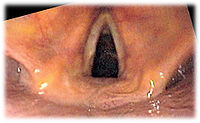
Photo from wikipedia
Neonates and small infants with craniofacial malformation may be very difficult or impossible to mask ventilate or intubate. We would like to report the fiberoptic intubation of a small infant… Click to show full abstract
Neonates and small infants with craniofacial malformation may be very difficult or impossible to mask ventilate or intubate. We would like to report the fiberoptic intubation of a small infant with Treacher Collins Syndrome using the technique described by Ellis et al. CASE REPORT An one month-old infant with Treacher Collins Syndrome was scheduled for mandibular surgery under general endotracheal anesthesia. Direct laryngoscopy for oral intubation failed to reveal the glottis. Fiberoptic intubation using nasal approach and using oral approach through a 1.5 size laryngeal mask airway were performed; however, both approach failed because the fiberscope loaded with a one 3.5mm ID uncuffed tube was stuck inside the nasal cavity or inside the laryngeal mask airway respectively. Therefore, the laryngeal mask airway was keep in place and the fiberoptic intubation technique described by Ellis et al. was planned: the tracheal tube with the 15mm adapter removed was loaded proximally over the fiberscope; the fiberscope was advanced under video-screen visualization into the trachea; the laryngeal mask airway was removed, leaving the fiberscope in place; the tracheal tube was passed completely through the laryngeal mask airway and advanced down over the fiberscope into the trachea; the fiberscope was removed and the 15mm adapter was reattached to the tracheal tube. CONCLUSION The fiberoptic intubation method through a laryngeal mask airway described by Ellis et al. can be successfully used in small infants with Treacher Collins Syndrome.
Journal Title: Revista brasileira de anestesiologia
Year Published: 2018
Link to full text (if available)
Share on Social Media: Sign Up to like & get
recommendations!